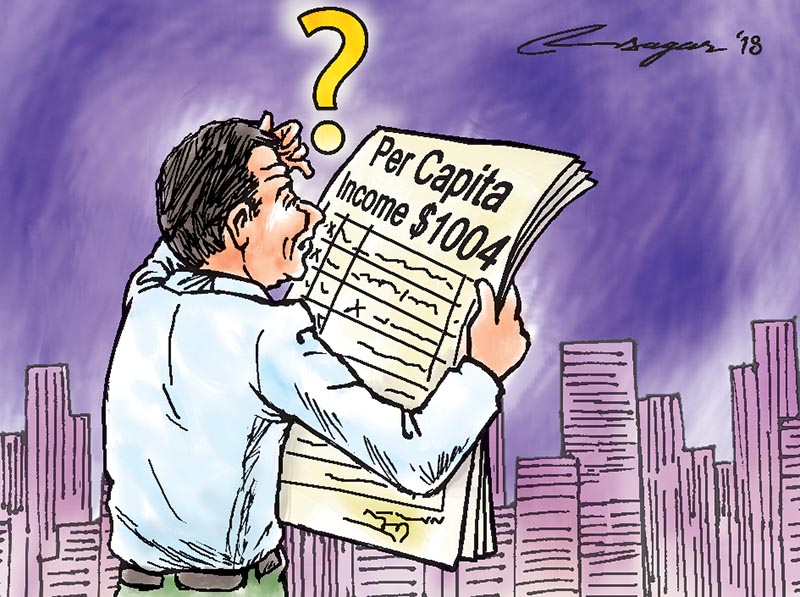Income conundrum: Dissecting PCI forecast
There is a need to understand that the CBS per capita income forecast of $1,004 for Nepalis for the ongoing fiscal is calculated as the nominal GDP divided by the total population, which does not give a clear picture to living standards of the people
The Central Bureau of Statistics (CBS) on Wednesday unveiled its economic forecast for the ongoing fiscal 2017-18, in which it projected Nepal’s economy to grow to Rs 3,007.25 billion and Nepalis’ per capita income (PCI) to cross the $1,004 mark. This drew huge attention of the press as well as the general public. But what exactly does this mean?
There are basically two major problems with the use of this measure of PCI.
First, this is calculated as the nominal gross domestic product (GDP) divided by the total population. The standard macroeconomics textbook defines nominal GDP as the sum of market value of all final goods and services produced within a country in a given period of time, where market value for each final goods and services is computed as the product of quantity and market prices for a given period.
For example, if we assume an economy with two final goods in the fiscal year 2016-17 – X and Y with quantities (units) of 10 and 20 and per unit prices of NPR 1 and NPR 2, then the nominal GDP will be NPR 50 in the fiscal year 2016-17. This shows that nominal GDP can increase either because quantities rise or because prices rise or both.
Now consider the numbers for the fiscal year 2017-18, where prices of both goods increase by NPR 0.1, without a subsequent increase in quantities. As a result of this price increase, nominal GDP increases from NPR 50 in 2016-17 to NPR 53 in 2017-18, and this corresponds to the annual economic growth rate of 6 per cent (relative to the fiscal year 2016-17). Note that this 6 per cent increase is merely due to the increase in prices. It would be thus misleading to say that the economic wellbeing of a country has increased in the fiscal year 2017-18 because quantities of both goods have not changed.
For this reason, economists do not consider nominal GDP as a measure of economic wellbeing, and hence per capita nominal GDP cannot be considered as a good measure of the average income of individuals in the economy.
Hence, it would be misleading to highlight Nepalis’ PCI for the 2017-18 as $ 1,004.
The question then is whether there is a good measure of PCI of Nepal that is expected for the fiscal year 2017-18. The CBS forecast does report this number but has not been highlighted. In particular, the CBS calculates this PCI as real GDP divided by population.
The major difference between nominal GDP and real GDP is that nominal GDP uses current market prices (market prices of the period during which nominal GDP is calculated), whereas real GDP uses constant market prices (market prices of a base period).
This implies that the change in real GDP reflects the change in quantities only whereas the change in nominal GDP reflects the changes in both quantities and prices.
A better measure of economic wellbeing of a country should only reflect the change in the quantities and should not be influenced by change in prices. This criterion makes real GDP a good measure of the economic wellbeing of a country.
In case of Nepal, the base period used for real GDP calculation is the fiscal year 2000-01.
Going back to our previous example with two-goods economy, and assuming the prices of those two goods in the fiscal year 2000-01 to be NPR 0.5 and NPR 1, the real GDP for the fiscal year 2017-18 would be NPR 25 vis-a-vis the nominal GDP of NPR 53, and that for the fiscal year 2016-17, the real GDP would be NPR 25 as compared to the nominal GDP of NPR 50.
Thus, the economy would witness an annual economic growth of 0 per cent in the fiscal year 2017-18 when using the real GDP and an annual economic growth of 6 per cent when using the nominal GDP.
It seems paradoxical that the CBS – and also the press – highlighted the economic growth of 5.89 per cent, computed using real GDP and not nominal GDP, while they did not do the same when it came to per capita income using real GDP.
As per the CBS, per capita real GDP is NPR 30,300, significantly lower than the per capita nominal GDP of NPR 103,335 (1USD=102.92).
The second reason why we should stick only to per capita real GDP is that the first target of Goal 8 (decent work and economic growth) of United Nations’ Sustainable Development Goals uses the annual growth rate of per capita real GDP as an indicator.
Further, the same target aims at achieving at least 7 per cent of the annual growth rate of per capita real GDP in the least developed countries.
The CBS expects the annual growth of per capita real GDP to be 4.87 per cent in 2017-18, significantly lower than the expected annual growth of per capita nominal GDP of 12.28 per cent for the same year.
In nine of the past 10 years, Nepal saw annual growth of per capita nominal GDP of more than seven per cent, but none of these years had the annual growth of per capita real GDP of more than 7 per cent. In fact, even during 2015-16, when Nepal had two major earthquakes, per capita nominal GDP growth was 5.22 per cent while the per capita real GDP growth was negative (-0.75 per cent).
Joshi is an economist at South Asia Regional Office of International Maize and Wheat Improvement Centre and Shrestha is a student of economics at New York University






